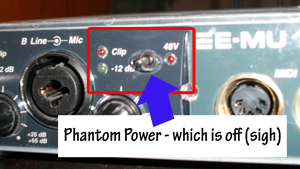 Phantom power is not supernatural, nor is it anything to do with with Andrew Lloyd Weber (snicker). So that is what it isn’t. What it is can be – gasp what a surprise – a bit confusing and “techie” sounding when someone tries to explain it. I asked someone for 400 words on what phantom power is and below was the result. Hint: take a big hit on your coffer, soda or 5-Hour Energy drink before proceeding. I will put up a now-what-is-it-really-and-only-tell-me-what-I-need-to-know post on phantom power soon.
Phantom power is not supernatural, nor is it anything to do with with Andrew Lloyd Weber (snicker). So that is what it isn’t. What it is can be – gasp what a surprise – a bit confusing and “techie” sounding when someone tries to explain it. I asked someone for 400 words on what phantom power is and below was the result. Hint: take a big hit on your coffer, soda or 5-Hour Energy drink before proceeding. I will put up a now-what-is-it-really-and-only-tell-me-what-I-need-to-know post on phantom power soon.
Phantom Power
Phantom power is a technical term used by audio aficionados which is the direct current smeared likewise through the two signal lines of a balanced audio connector. When the concept of phantom power was brought about, one of its benefits was that the same type of balanced and shielded microphone cables that well equipped studios were typically using for microphones, could now be used for condenser microphones. This is different than the uses for the usual dynamic microphones. The traditional circuitry of most of the microphone equipment requires special multi-conductor cables. Phantom power alleviated some of these needs.
Supplying phantom power can be achieved by microphone or other device and obtain DC power from either allowing two capacitors to block DC power from registering at the output or running a signal line to a ground terminal. Appropriate settings for R1 and R2 has to be 6.8k ohms for 48 volt phantom, and R3 will not be used in this case. Phantom power can effectively and seamlessly supply voltage to well-adjusted microphones that do not use it. Most vibrant microphones would be included. The only difference in voltage amid two signal lines of a balanced signal will be noted as phantom powering spaces identical DC voltage on either signal lines of the balanced connection.
In contrast to earlier methods of powering, in which DC had a direct overlay onto the indicator in disparity mode. This method was of German origin and referred to as “Parallel Powering” or “T-Powering”. The connection of a orthodox microphone to an input that had one or the other between T-powering or parallel powering facilitated can harm the microphone.
Phantom powering isn’t without its flaws. It can cause significant damage or equipment malfunction when cast-off with adapters or cables that connect either of the sides of the common input to earth. This is especially the case when different equipment besides microphones are linked to it. To avoid theses perils numerous mixer boards have a switch that serves as a tool for switching phantom power on or off. Most high-end gear this is achieved individually by a channel setting. On lesser mixers most if not all microphone channels can be set either on or off. This can also be done in groupings of most mid-range boards as well as some of the small ones. Disconnecting an individual channel from phantom power shouldn’t prove to be too difficult. This can be completed by means of a 1:1 seclusion blocking capacitors or transformer.
Leave a Reply